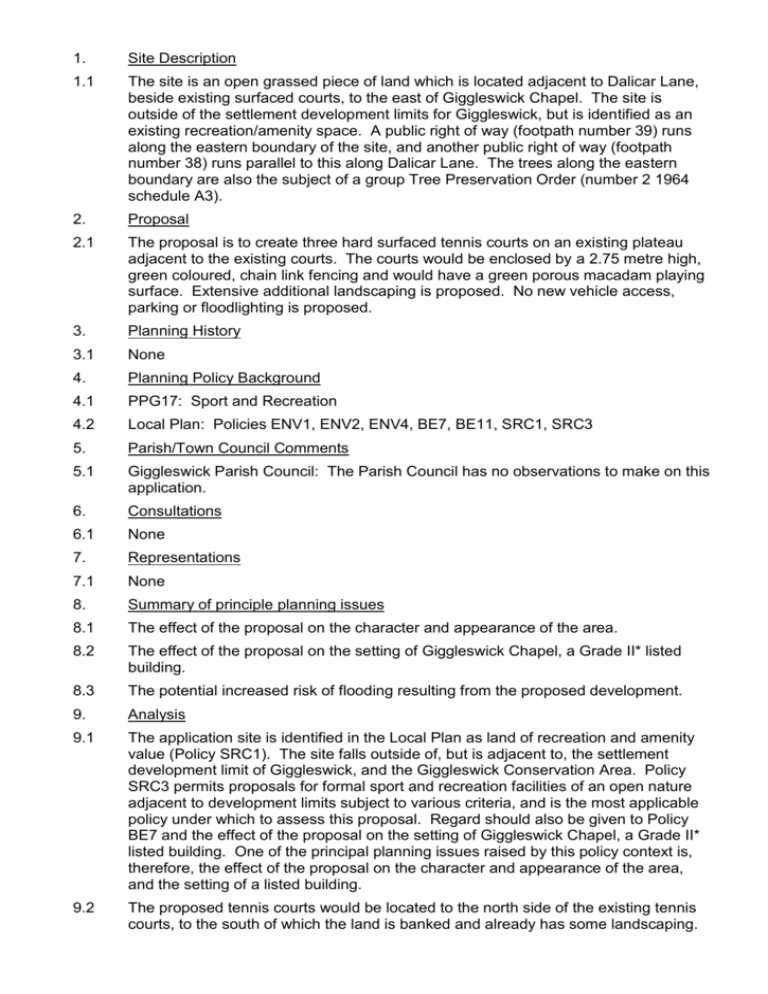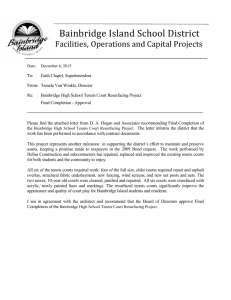1 - Craven District Council Online Planning
advertisement

1. Site Description 1.1 The site is an open grassed piece of land which is located adjacent to Dalicar Lane, beside existing surfaced courts, to the east of Giggleswick Chapel. The site is outside of the settlement development limits for Giggleswick, but is identified as an existing recreation/amenity space. A public right of way (footpath number 39) runs along the eastern boundary of the site, and another public right of way (footpath number 38) runs parallel to this along Dalicar Lane. The trees along the eastern boundary are also the subject of a group Tree Preservation Order (number 2 1964 schedule A3). 2. Proposal 2.1 The proposal is to create three hard surfaced tennis courts on an existing plateau adjacent to the existing courts. The courts would be enclosed by a 2.75 metre high, green coloured, chain link fencing and would have a green porous macadam playing surface. Extensive additional landscaping is proposed. No new vehicle access, parking or floodlighting is proposed. 3. Planning History 3.1 None 4. Planning Policy Background 4.1 PPG17: Sport and Recreation 4.2 Local Plan: Policies ENV1, ENV2, ENV4, BE7, BE11, SRC1, SRC3 5. Parish/Town Council Comments 5.1 Giggleswick Parish Council: The Parish Council has no observations to make on this application. 6. Consultations 6.1 None 7. Representations 7.1 None 8. Summary of principle planning issues 8.1 The effect of the proposal on the character and appearance of the area. 8.2 The effect of the proposal on the setting of Giggleswick Chapel, a Grade II* listed building. 8.3 The potential increased risk of flooding resulting from the proposed development. 9. Analysis 9.1 The application site is identified in the Local Plan as land of recreation and amenity value (Policy SRC1). The site falls outside of, but is adjacent to, the settlement development limit of Giggleswick, and the Giggleswick Conservation Area. Policy SRC3 permits proposals for formal sport and recreation facilities of an open nature adjacent to development limits subject to various criteria, and is the most applicable policy under which to assess this proposal. Regard should also be given to Policy BE7 and the effect of the proposal on the setting of Giggleswick Chapel, a Grade II* listed building. One of the principal planning issues raised by this policy context is, therefore, the effect of the proposal on the character and appearance of the area, and the setting of a listed building. 9.2 The proposed tennis courts would be located to the north side of the existing tennis courts, to the south of which the land is banked and already has some landscaping. Immediately to the west the site is enclosed by a limestone rock outcrop which rises nearly four metres above the level of the site itself. Beyond this rock outcrop, approximately 26 metres from the site, is the east facing elevation of Giggleswick Chapel. To the north of the site there are existing grass courts with Craven Bank Lane beyond. A footpath runs across part of this area and connects to Craven Bank Lane. The east of the site is bordered by a number of mature trees (a mix of Sycamore and Ash ranging between 10 and 18 metres in height) which are the subject of group TPO. The land falls away beyond these trees to Dalicar Lane (a unmade road/track) and also a public right of way. 9.3 The proposed surfacing for the courts is a porous Macadam coloured dark green and it is proposed to construct the fencing to a height of 2.75 metres and coloured dark green. The alignment of the courts is on a north – south axis, which creates a ‘snug’ fit within the natural existing boundaries of the site. An extensive detailed landscaping scheme has been submitted which includes proposals to maintain existing coverage and thin out poor specimens and alien species (there are some conifers to the south of the site). In relation to the trees covered by the TPO, detailed proposals have been submitted which include some crown lifting of the specimens adjacent to the proposed court. Additional planting is also proposed to the south and west of the site which will provide additional screening and enclosure for the courts. To the north of the site, a small landscaped mound is proposed again with extensive additional planting. 9.4 The proposed height of the fencing is reasonable and is unlikely in itself to have an overbearing effect on the character of the area, and the proposed colour of the fencing should also assist with minimising any potential visual impact. More importantly however, the rock outcrop to the west and the difference in levels between the site and the adjacent Chapel help to provide a natural screen for the proposed courts. The additional landscaping will further soften the boundaries between the Chapel and the tennis courts. 9.5 Given the nature of the existing landform around the site and the existing level of screening, coupled with the proposals for additional planting and the actual nature of the development itself, the proposal is unlikely to have any significant adverse effect on the character and appearance of the area. Similarly, the proposal is unlikely to any undue adverse effect on the setting of the Chapel for the same reasons. 9.6 With regard, to the amenity of any nearby residents, the proposed courts are situated well away from the main residential areas within the village. Given that the proposal is for tennis courts with no floodlighting or associated car parking, the potential level and timing of use of the courts is unlikely to have an adverse effect on the private residential amenities of people living in the village. 9.7 Previous proposals by Giggleswick School have raised an issue of the potential to increase the risk of flooding by increasing water run off into Tems Beck, although no objections have been received on this application. In this regard, specific drainage proposals have been included with this submission which suggest the courts have been designed with a porous surface and shallow cross fall in order to minimise excess water run off, and that the sub base itself has been designed to store water and act as a soakaway. A new french drain arrangement is also proposed on three sides of the tennis courts to intercept any additional water run off to a new drainage balancing feature. 9.8 The porous surface and landscape balancing feature should ensure that there is no need to pipe any drainage to sewers or watercourses and this is confirmed on the submitted application forms. Neither the Council’s Environmental Health services or the Environment Agency have raised any specific concerns about these proposals. 10. Recommendation 10.1 Approval 11. Summary of Conditions 11.1 Standard time limit. 11.2 The development hereby approved shall be carried out in accordance with the approved amended plans (reference 1196/150/A; 1196/152; and 1196/156) and design statement submitted by Brown Associates on the 24th June 2002. 11.3 All planting shall be carried out in accordance with the approved details (as set out in drawing number 1196/150/A submitted by Brown Associates on the 30 th September 2002) prior to the development hereby approved being brought in to use. If within a period of two years from the date of the planting of any tree that tree, or any tree planted in replacement for it, is removed, uprooted or destroyed or dies, or becomes, in the opinion of the District Planning Authority, seriously damaged or defective, another tree of the same species and size as that originally planted shall be planted at the same place, unless the District Planning Authority gives its written consent to any variation. 11.4 Reason: For the avoidance of doubt and to ensure that the proposed landscaping works are completed prior to the development hereby approved being brought in to use. 11.5 In this condition “retained tree” means an existing tree which is to be retained in accordance with the approved plans; and paragraphs a) and b) below shall have effect until the expiration of 2 years from the date of the completion of the development hereby granted. 11.6 a) No retained tree shall be cut down, uprooted or destroyed, nor shall any retained tree be topped or lopped other than in accordance with the approved plans, without the written approval of the local planning authority. Any topping or lopping approved shall be carried out in accordance with British Standard 3998 (Tree Work). 11.7 b) If any retained tree is removed, uprooted or destroyed or dies, another tree shall be planted at the same place and that tree shall be of such size and species, and shall be planted at such time, as may be specified in writing by the local planning authority. 11.8 (c)The erection of fencing for the protection of any retained tree shall be undertaken in accordance with the approved details (as set out on plan number 1196/156 submitted by Brown associates on the 24th June 2002) before any equipment, machinery or materials are brought on to the site for the purposes of the development, and shall be maintained until all equipment, machinery and surplus materials have been removed from the site. Nothing shall be stored or placed in any area fenced in accordance with this condition and the ground levels within those areas shall not be altered, nor shall any excavation be made, without the written consent of Craven District Council. 11.9 Reason: To ensure that existing trees are retained in the interests of amenity and to fulfil the requirements of section 197 of the Town and Country Planning Act 1990. 11.10 No light fitting, source of external illumination or scheme of floodlighting shall be erected on the site without the prior written approval of the District Planning Authority. 11.11 Reason: A scheme of floodlighting in this particular location may potentially have an adverse effect both on the character and appearance of the area, and on the setting of the adjacent listed building.









